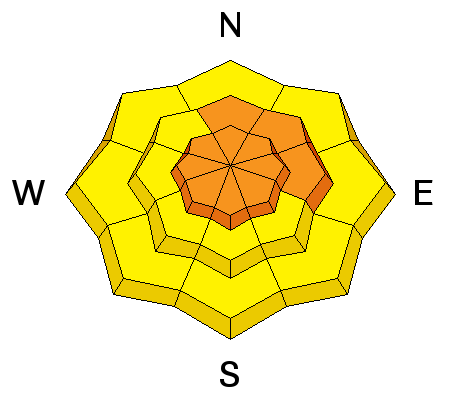| Please join us at the 23rd annual Black Diamond Fall Fundraiser Party Thursday Sept 15. Tickets are on sale now here, at the Black Diamond store & at REI. Special bonus raffle for online ticket purchasers! |  |

| Please join us at the 23rd annual Black Diamond Fall Fundraiser Party Thursday Sept 15. Tickets are on sale now here, at the Black Diamond store & at REI. Special bonus raffle for online ticket purchasers! |  |
| Advisory: Logan Area Mountains | Issued by Toby Weed for Thursday - February 4, 2016 - 7:33am |
|---|
 |
current conditions There's a couple inchs of light new snow from overnight and the temperature is 12 degrees this morning at the 8400' Tony Grove Snotel. There's 75 inches of total snow, containing 106% of average water content for the date. The 9700' CSI Logan Peak weather station reports 7 degrees and currently 20 mph winds from the southwest. We've found the best powder riding conditions recently in sheltered lower angled terrain, and there are still probably steeper areas with dangerous avalanche conditions. Drifting of today's light snow will create new wind slabs, and triggered (and probably mostly manageable) shallow avalanches are likely at upper elevations. Our main concern is the lingering possibility of deep slab avalanches on drifted upper elevation slopes with shallow overall snow cover. Beware areas that avalanched earlier in the winter.
|
 |
recent activity Sad news of an avalanche fatality in the backcountry near The Canyons in Park City. A 50-year-old lone backcountry skier was caught and buried by an avalanche on Sunday. His body was located by beacon search yesterday afternoon (2-2-16). Here is our Preliminary Accident Report. We noticed a fresh deep slab avalanche on Monday in the Oscar Mayer slide path in Logan Dry Canyon. A local observer skied the line on Sunday afternoon before the east winds picked up Sunday night, and the sizable avalanche must have occurred overnight or early in the morning of February 1. Report is HERE A fresh natural deep slab was observed in Logan Dry Canyon (Oscar Mayer) on February 1. It was likely a natural caused by a period of east wind overnight (1-31-16,) which drifted snow onto the slope, overloading weak faceted snow or depth hoar near the ground. (Glew, 2-1-2016) Looks like a fairly widespread natural avalanche cycle over the weekend, with numerous large and long running avalanches visible in the generally east facing avalanche paths in the Wood Camp Area and in the Wellsville Range. A hiker on snow-shoes triggered and may have been caught in a loose avalanche at the mouth of Logan Dry Canyon Saturday. And, it looks like a pedestrian sledder might have taken a similar ride in loose snow over the weekend at the very bottom of Green Canyon. There were several (apparently manageable) human triggered avalanches in the Logan Zone last week. These on north through east facing upper and mid elevation slopes were around a foot deep and up to about 50' wide. A video posted on Facebook from a large sled triggered avalanche (1-19-16) in Christmas Tree Bowl is .....HERE ***To view our updated list of backcountry observations and avalanche activity from around Utah, go to our observations page
|
| type | aspect/elevation | characteristics |
|---|


|


|

LIKELIHOOD
 LIKELY
UNLIKELY
SIZE
 LARGE
SMALL
TREND
 INCREASING DANGER
SAME
DECREASING DANGER
|
|
description
You're likely to trigger wind slab avalanches in exposed upper elevation terrain. Avoid fresh and forming drifts near ridge tops and in and around terrain features like gullies, sub-ridges, scoops, and rock outcroppings. Older stiff wind slabs failing on preexisting weak surface snow are still possible in steep wind exposed terrain today. Hard wind slabs have the nasty tendency to sometimes allow you to get out on them before releasing.
|
| type | aspect/elevation | characteristics |
|---|


|


|

LIKELIHOOD
 LIKELY
UNLIKELY
SIZE
 LARGE
SMALL
TREND
 INCREASING DANGER
SAME
DECREASING DANGER
|
|
description
Heavy snow over the weekend overloaded a complex snowpack, with existing buried persistent weak layers in some areas and still weak basal layer depth hoar in others. Triggered deep slab avalanches remain possible in some areas today. Weak snow structure exists mainly in areas where the total snow is 3' deep or less. Avalanches are most likely in shallow rocky upper elevation terrain, especially where avalanches occurred earlier in the season, but the shallow snow is still also weak in many areas at lower and mid elevations. I'm finding propagation in most of my snowpit tests in shallower snow these days, with failures common in loose sugary faceted snow in the basal layers. ***Pay close attention to signs of unstable snow like recent avalanches, whumpfing, and shooting cracks, and be willing to reevaluate your plans. In these conditions you could trigger avalanches remotely, from a distance or worse, from below!
|
 |
weather A weak disturbance will cross northern Utah today and another will swing by tonight. High temperatures at 8500' are expected to be around 22 degrees, there will be a moderate west wind (15-20 mph), and we could see 2 to 4 inches of accumulation. Snow will redevelop tonight, with low temperatures around 13 degrees and continuing and a little stronger west-northwest wind. 2 to 4 inches more accumulation possible. A strong high pressure system will build over the area for the end of the week.. |
| general announcements Please submit snow and avalanche observations from your ventures in the backcountry HERE. You can call us at 801-524-5304 or email HERE, or include #utavy in your Instagram or Tweet us @UAClogan. To report avalanche activity in the Logan Area or to contact the local avalanche forecaster call me, Toby, at 435-757-7578. I'll update this advisory throughout the season on Monday, Wednesday, Friday, and Saturday mornings by about 7:30 This advisory is produced by the U.S.D.A. Forest Service, which is solely responsible for its content. It describes only general avalanche conditions and local variations always exist. |
Advisory Hotline: (888) 999-4019 | Contact Information